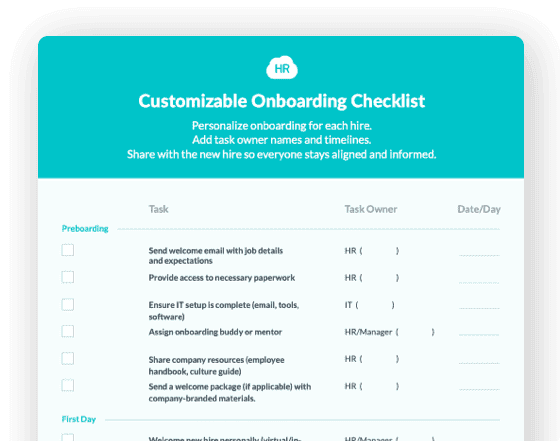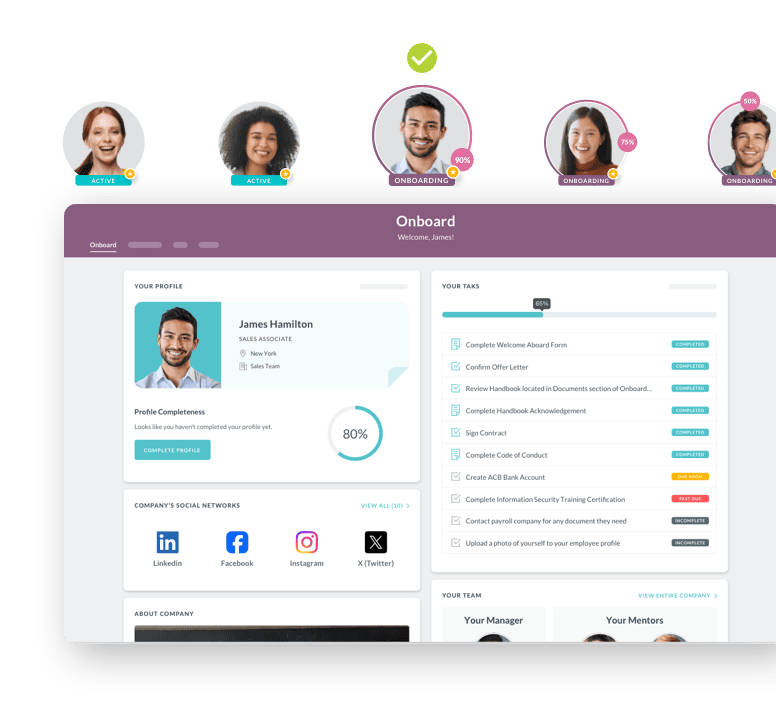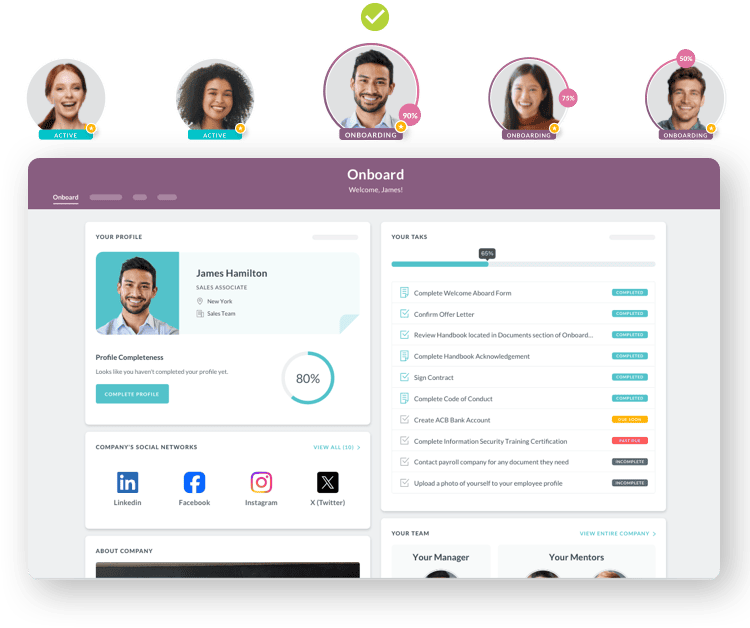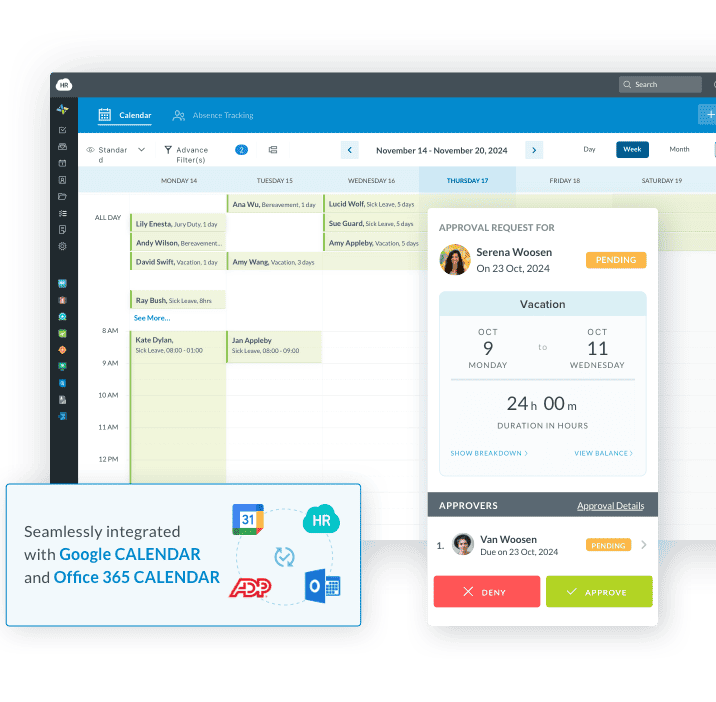Exempt Test
- Essential Elements Every Business Leader Should Know About the Exempt Test
- Comparing the Three Main Exemption Categories
- Proven Strategies for Correctly Applying the Exempt Test
- Critical Mistakes That Trigger Misclassification Liability
- How Different Industries Navigate Exempt Test Complexity
- Your Implementation Roadmap for Exempt Test Compliance
- Your Implementation Roadmap for Exempt Test Compliance

 Cut onboarding time
by 60%—here's the
Ultimate Checklist
that helped do it.
Cut onboarding time
by 60%—here's the
Ultimate Checklist
that helped do it.

Understanding whether your employees qualify as exempt or nonexempt from overtime pay is one of the most consequential decisions you'll make as a business leader. Get it wrong, and you face costly wage and hour lawsuits, Department of Labor penalties, and employee morale problems that ripple through your organization. The exempt test is the systematic evaluation process that determines which employees must receive overtime compensation and which can be classified as exempt from these requirements under the Fair Labor Standards Act.
This classification affects more than just payroll calculations. It shapes your organizational structure, influences hiring decisions, impacts your labor budget, and determines your legal compliance risk. Misclassification remains one of the most expensive HR compliance mistakes companies make, with FLSA violations resulting in fines up to $2,451 per violation for willful cases. Yet many organizations still struggle with applying the exempt test correctly, often relying on outdated assumptions about what makes someone exempt.
The exempt test consists of three distinct components that work together to determine classification. An employee must pass all three tests to qualify as exempt from overtime requirements. These are the salary basis test, the salary level test, and the duties test. Each serves a specific purpose in identifying truly exempt positions, and failing any single test means the employee must be classified as nonexempt and eligible for overtime pay at one and a half times their regular rate for hours worked beyond 40 in a workweek.
According to the Department of Labor and SHRM, employees must meet both salary and duties requirements to qualify for exemption. This dual requirement prevents employers from simply paying a salary to avoid overtime obligations while assigning primarily nonexempt work. The system protects workers who perform routine tasks from being reclassified as exempt without meaningful changes to their responsibilities.
Essential Elements Every Business Leader Should Know About the Exempt Test
The exempt test framework contains critical components that business decision makers must understand to classify employees correctly:
-
The salary basis test requires that exempt employees receive a predetermined fixed amount each pay period that does not fluctuate based on hours worked or quality of work performed, protecting employees from arbitrary salary reductions while establishing predictable compensation.
-
The salary level test sets minimum weekly earnings thresholds that change periodically through Department of Labor regulations, currently requiring most exempt employees to earn at least $684 per week or $35,568 annually to qualify for exemption.
-
The duties test evaluates the actual work employees perform to determine if their primary responsibilities genuinely involve executive, administrative, or professional functions that justify exempt classification rather than routine operational tasks.
-
The primary duty standard focuses on what employees spend most of their time doing, not their job title or occasional responsibilities, with a presumption that duties consuming more than 50% of work time constitute the primary duty for classification purposes.
-
The highly compensated employee exception provides an alternative path to exemption for workers earning at least $132,964 annually who customarily perform at least one exempt duty, recognizing that high earners typically exercise significant discretion regardless of specific title.
-
State law variations create additional complexity because some states set higher salary thresholds or stricter duties requirements than federal law, requiring employers to apply whichever standard most favors the employee in their jurisdiction.
Comparing the Three Main Exemption Categories
|
Exemption Type |
Primary Duty Requirements |
Typical Positions |
Key Distinguishing Factor |
|
Executive |
Management of enterprise or department, regularly directs two or more full-time employees, authority to hire/fire or recommendations carry significant weight |
Department heads, general managers, division directors, store managers with hiring authority |
Focus on supervision and organizational impact through personnel decisions |
|
Administrative |
Office or non-manual work related to management or business operations, exercises discretion and independent judgment on matters of significance |
HR managers, purchasing agents, financial controllers, executive assistants to senior leadership |
Work directly supports business operations rather than producing the primary product or service |
|
Professional |
Work requiring advanced knowledge in a field of science or learning acquired through prolonged specialized instruction, or creative and original work in artistic fields |
Doctors, lawyers, engineers, architects, certified public accountants, teachers, creative writers |
Advanced education requirement or artistic originality rather than routine mental or manual labor |
|
Computer |
Systems analysis, programming, software engineering, or similar skilled work in computer field as primary duty |
Software developers, systems analysts, computer programmers designing complex systems |
Specialized computer expertise rather than general IT support or routine computer use |
Proven Strategies for Correctly Applying the Exempt Test
Accurate classification requires disciplined processes that go beyond superficial job title analysis. Organizations that maintain compliance follow these systematic approaches:
Begin with comprehensive position analysis that examines what employees actually do rather than what job descriptions say they should do. Conduct structured interviews with both the employee and their direct supervisor to understand daily activities, decision-making authority, and time allocation across different tasks. Many misclassification problems stem from outdated job descriptions that no longer reflect evolved responsibilities. Your HRIS platform should maintain current documentation that supports classification decisions with specific evidence.
Document your classification decisions with detailed rationale that demonstrates how each position meets or fails the three exempt tests. Create a written analysis for every exempt position showing the salary amount, confirmation of salary basis payment, and specific duties that satisfy one of the exemption categories. This documentation becomes invaluable during Department of Labor audits or wage and hour lawsuits. Courts consistently rule against employers who cannot produce contemporaneous records supporting their classification choices.
Apply the duties test based on actual work performed, not potential or aspirational duties. An employee's job duties must primarily involve the exempt functions, typically meaning they spend at least half their time on qualifying work. A retail supervisor who spends 60% of their time performing the same tasks as hourly associates fails the duties test regardless of their title or occasional supervisory responsibilities. Focus your analysis on what happens most days in typical weeks rather than exceptional circumstances or busy seasons.
Review classifications annually or whenever job responsibilities change significantly. Positions evolve as businesses grow, technology advances, and organizational structures shift. An employee who qualified as exempt three years ago might now perform primarily nonexempt work after restructuring transferred their decision-making authority to others. Schedule systematic reviews of all exempt positions using automated compliance workflows that flag positions requiring reassessment based on role changes, salary adjustments, or regulatory updates.
Consult employment law counsel for borderline cases where classification remains unclear after thorough analysis. Some positions genuinely fall into gray areas where reasonable arguments support both exempt and nonexempt classification. In these situations, the conservative approach protects your organization better than aggressive classification that maximizes exempt designations. Legal fees for proactive advice cost far less than defending wage and hour class actions or repaying years of back overtime.
 Ready to pass your next audit—without the stress? See how you can simplify compliance and eliminate gaps before they become problems.
Ready to pass your next audit—without the stress? See how you can simplify compliance and eliminate gaps before they become problems.


Critical Mistakes That Trigger Misclassification Liability
Even sophisticated organizations make predictable errors when applying the exempt test. Awareness of these common pitfalls helps you avoid expensive compliance failures:
Classifying employees as exempt solely based on job titles represents one of the most dangerous misconceptions about FLSA exemptions. FLSA status is determined based on the duties of a position and not the position title, meaning two positions with the same official title can have different FLSA statuses. Your "Assistant Manager" title doesn't create exemption if the employee lacks genuine supervisory authority or spends most time on nonexempt production work. Focus exclusively on actual responsibilities and compensation when making classification decisions.
Paying a salary without verifying the duties test creates false confidence about exemption status. Many employers assume that converting someone from hourly to salaried automatically makes them exempt from overtime requirements. The reality is more nuanced. An employee paid $50,000 annually who performs routine clerical tasks remains nonexempt despite receiving a salary. The classification of jobs depends primarily on work content rather than payment structure alone.
Misunderstanding the management requirement for executive exemption leads to improper classification of team leaders and working supervisors. Simply directing a few employees' work doesn't satisfy the executive duties test. The employee must have genuine hiring and firing authority or make recommendations about personnel actions that carry particular weight with decision makers. A shift supervisor who assigns tasks but lacks input on employment decisions typically fails the executive test.
Confusing specialized knowledge with professional exemption causes problems in technical fields. The professional exemption requires work in a field of science or learning that typically requires advanced education and prolonged specialized instruction, not just experience or on-the-job training. A highly skilled computer repair technician who learned through practice rather than formal computer science education likely doesn't meet the learned professional standard even though their knowledge is specialized.
Failing to update classifications when the Department of Labor raises salary thresholds creates instant misclassification for employees who previously qualified. Regulatory changes periodically increase the minimum salary level, and employees below the new threshold become nonexempt automatically even if nothing else about their job changes. Monitor DOL announcements and budget for salary adjustments or reclassification when new regulations take effect.
How Different Industries Navigate Exempt Test Complexity
The exempt test applies universally across industries, but practical application varies based on workforce composition and operational models:
Healthcare organizations face unique challenges with clinical and administrative staff classifications. Physicians, nurses, and other licensed healthcare professionals may qualify under the professional exemption based on their advanced training and independent judgment in patient care. However, healthcare HR teams must carefully evaluate administrative positions like office managers, scheduling coordinators, and billing supervisors. These roles often involve discretionary decision making that could support administrative exemption, but only if employees truly exercise independent judgment on significant matters rather than following established procedures for routine tasks. Many healthcare compliance violations involve misclassified administrative staff who perform important work without sufficient autonomy to qualify as exempt.
Retail and hospitality businesses struggle with store manager and department supervisor classifications. These frontline leaders typically carry impressive titles and receive salaries, creating the appearance of exempt status. However, the reality often contradicts the classification. Many store managers spend the majority of their time performing the same customer service, sales, or food preparation work as hourly employees. They might have limited authority over hiring decisions and follow detailed corporate protocols that leave little room for independent judgment. Examples of occupations typically encountered in the exempt categories include general managers with hiring and firing authority and department heads who have personnel decision authority, not working supervisors who primarily perform operational tasks.
Technology companies face classification questions around software developers, IT support staff, and systems administrators. Software engineers designing complex programs or systems typically qualify under either the professional or computer employee exemptions. However, IT support technicians who troubleshoot user problems by following established procedures generally remain nonexempt regardless of their technical expertise. The distinguishing factor involves whether the work requires creative problem solving and system design versus applying predetermined solutions to common issues. Organizations should use employee self-service systems to track actual time allocation across different types of work when evaluating borderline technical positions.
Your Implementation Roadmap for Exempt Test Compliance
Establishing and maintaining proper classification requires systematic processes that become part of your regular HR operations:
First, conduct a comprehensive audit of all current exempt positions using structured analysis tools. Create a detailed worksheet for each exempt employee that documents their salary, confirms salary basis payment, and lists specific duties with time percentages. Compare these duties against the regulatory requirements for their claimed exemption category. Identify positions where documentation is weak or classification appears questionable. This baseline assessment reveals your current compliance status and prioritizes positions needing immediate attention.
Second, develop standardized classification procedures that guide consistent decision making across your organization. Create detailed guidelines explaining each exemption category with industry-specific examples relevant to your business. Establish approval workflows requiring HR review and legal sign-off for all new exempt classifications. Build templates that hiring managers complete when proposing exempt positions, forcing them to articulate specific duties that satisfy the tests rather than relying on titles or assumptions.
Third, implement regular monitoring systems that flag classification issues before they become compliance violations. Program your time tracking software to alert managers when exempt employees consistently work excessive overtime, which might indicate inadequate staffing rather than appropriate exempt workload. Schedule quarterly reviews where supervisors certify that exempt employees' duties haven't changed materially. Use organizational changes like restructuring or role modifications as triggers for automatic classification review.
Fourth, train managers and supervisors on their role in maintaining proper classification. Many classification problems originate when supervisors assign inappropriate tasks without considering FLSA implications. Teach managers how shifting responsibilities to exempt employees can affect their classification status. Emphasize that maintaining exemption requires preserving the employee's primary duties within exempt categories. Create simple decision trees that help supervisors evaluate whether proposed changes might jeopardize exempt status.
Fifth, establish clear procedures for handling classification changes including transparent communication with affected employees. When you must reclassify someone from exempt to nonexempt, frame it as a compliance requirement rather than a demotion. Explain overtime payment benefits and establish clear expectations about work hours and authorization procedures. Consider timing adjustments strategically to coincide with other positive changes like raises that offset any perceived status loss.
Sixth, document everything related to classification decisions and maintain organized records that withstand audit scrutiny. Store job descriptions, duty analysis worksheets, approval documentation, and periodic review confirmations in secure HRIS files linked to each employee's record. When the Department of Labor investigates or employees file wage claims, comprehensive documentation often determines the outcome. Courts consistently favor employers who demonstrate thoughtful, contemporaneous classification analysis over those who cannot explain their reasoning.
Emerging Trends Reshaping Exemption Classification
The exempt test framework continues evolving as work itself transforms and regulatory approaches adapt to new realities:
Remote work arrangements complicate duties test application when managers cannot directly observe how employees spend their time. The shift toward distributed workforces makes it harder to verify that exempt employees truly perform their claimed duties rather than mixing exempt and nonexempt work at home. Smart employers implement regular virtual check-ins focused specifically on work content rather than just outcomes. Technology that tracks project activities without invasive monitoring helps document how remote employees allocate time across different responsibilities, supporting classification decisions with objective data.
Artificial intelligence and automation are reshaping which positions require the advanced judgment that justifies exempt classification. As AI handles increasingly sophisticated analytical tasks, roles that previously required significant discretion may become more routine. According to Harvard Business Review, AI systems now predict outcomes and recommend actions in areas that traditionally required human judgment, potentially converting some administrative positions to nonexempt status. Forward-thinking organizations anticipate these shifts by regularly reassessing whether positions still meet duties tests as technology assumes decision-making functions.
Gig economy and flexible work arrangements challenge traditional classification frameworks designed around full-time employees in stable positions. While independent contractors fall outside FLSA protections entirely, misclassification between employee versus contractor status represents a distinct issue from exempt versus nonexempt classification. Companies increasingly face dual classification risks where they must first correctly classify workers as employees rather than contractors, then properly classify those employees as exempt or nonexempt. Both decisions carry significant liability exposure requiring careful analysis.
Salary threshold adjustments continue trending upward as the Department of Labor periodically updates minimum compensation levels to reflect wage growth. Recent federal rulemaking increased the standard salary level to account for earnings growth and restore the threshold's screening function, with further increases likely in coming years. Organizations should budget for ongoing salary adjustments to maintain exempt status for borderline positions rather than reclassifying roles each time thresholds rise. Strategic compensation planning incorporates projected regulatory changes into multi-year projections.
State-level regulations increasingly diverge from federal standards, creating complex multi-jurisdictional compliance requirements for employers with workers in multiple locations. California, New York, and other states have implemented salary thresholds significantly higher than federal minimums along with stricter duties test interpretations. Employers can no longer rely on single nationwide classification policies but must adapt to varying requirements across their geographic footprint. Cloud-based HR systems that accommodate location-specific rules become essential for managing this complexity.
Employee expectations about work-life balance influence how organizations structure exempt positions and manage workloads. While exempt status technically allows unlimited hours without additional compensation, excessive overtime demands drive turnover among high-performers who have employment options. Smart organizations recognize that sustainable workloads matter even for exempt employees. They monitor work hours, adjust staffing when exempt employees consistently work unreasonable schedules, and create cultures where exemption doesn't mean exploitation. This approach protects both employee wellbeing and reduces reclassification pressure from employees who feel overworked.
The exempt test represents far more than a technical exercise in regulatory compliance. It fundamentally defines your employment relationships, shapes your organizational structure, and determines significant portions of your labor costs. Getting classification right requires understanding the three-part test thoroughly, applying it consistently based on actual duties rather than titles or assumptions, and maintaining vigilant oversight as positions evolve. Organizations that treat classification as a strategic HR function rather than an administrative task protect themselves from costly violations while building more equitable, transparent employment practices that support both business objectives and employee interests. Invest in proper classification systems, train your management team, and review decisions regularly to ensure your approach remains compliant as regulations, work arrangements, and job responsibilities continue evolving.


Keep Reading
From Manual to Automated: A Complete Guide to Digitizing Employee Onboarding for Large Organizations
Sarah Chen, Director of HR at a 7,000-employee healthcare organization, starts her Monday
Enterprise HR Software in 2025: Why Traditional Enterprise Platforms Fall Short and What Actually Works
Traditional enterprise human resources software systems promise comprehensive solutions
AI in Onboarding: Complete Guide for 2026
You’ve probably been hearing this multiple times a day — AI is transforming HR. But
Ready to streamline your onboarding process?
Book a demo today and see how HR Cloud can help you create an exceptional experience for your new employees.







